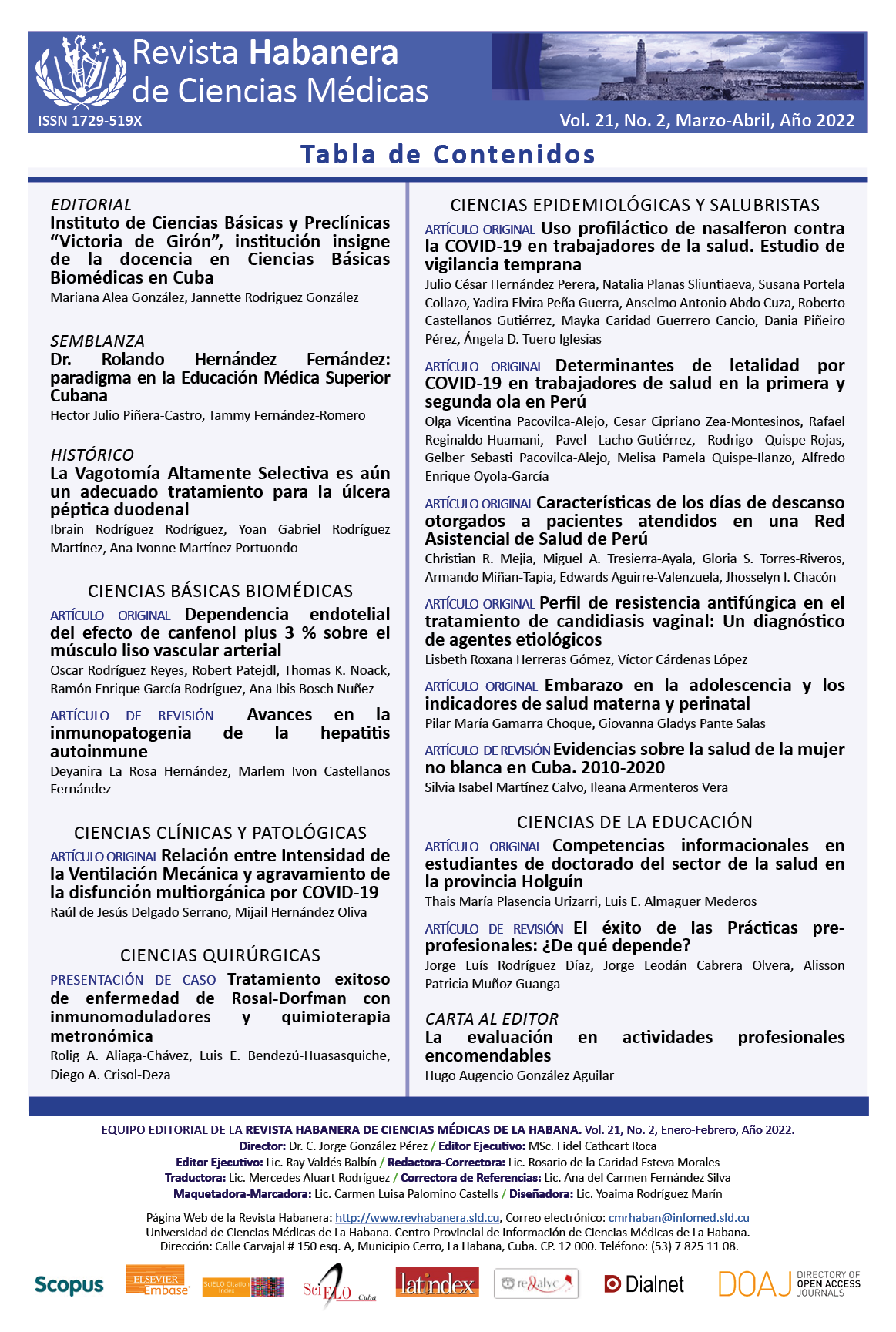Adolescent pregnancy and maternal and perinatal health indicators
Keywords:
Pregnancy, maternal health, adolescent, mortality, morbidity.Abstract
Introduction: Adolescent pregnancy is a public health problem with recognized influence on the socioeconomic and psycho-emotional aspects of the pregnant woman, which can influence maternal health indicators.
Objective: To determine the impact of adolescent pregnancy on maternal and perinatal health indicators.
Material and Methods: A retrospective and descriptive study was conducted in a population of 5 920 pregnant women attended at the Hospital San Juan de Lurigancho during 2018 to determine maternal health indicators such as maternal mortality and morbidity rate (MMR and MMR) and perinatal (MMR and PMR), considering two groups of analysis that included pregnant women between 10 and 19 years of age and those older than 19 years of age.
Results: There were 14,5 % of deliveries in adolescent women between 10 and 19 years of age, a group in which MMR and PMR were 10,8 and 80,3 respectively, in contrast to the rates of 8,8 and 43,3 in the group of pregnant women older than 19 years of age. The PMR was 6,9 and 10,4 in the groups of pregnant adolescent women and adult women, respectively, while the MMR was 19,9 in adult women. No deaths were recorded in adolescent patients.
Conclusions: Adolescent pregnancy significantly influenced the maternal health indicator PMR, probably due to the lack of early prenatal control, as well as the immaturity and the bony structure of the pelvis, being factors that can determine health problems in neonates.Downloads
References
1. Karataşlı V, Kanmaz AG, İnan AH, Budak A, Beyan E. Maternal and neonatal outcomes of adolescent pregnancy. Journal Gynecology Obstetrics and Human Reproduction [Internet]. 2019;48(5):[Aprox. 4p.]. Disponible en: https://doi.org/10.1016/j.jogoh.2019.02.011
2. Organización Mundial de la Salud. El embarazo en la adolescencia, datos y cifras [Internet]. Ginebra: OMS; 2020 [Citado15/03/2021]. Disponible en: https://www.who.int/es/news-room/fact-sheets/detail/adolescent-pregnancy
3. Sedgh G, Finer LB, Bankole A, Eilers MA, Singh S. Adolescent pregnancy, birth, and abortion rates across countries: levels and recent trends. J Adolesc Health Publ Soc Adolesc Med [Internet]. 2015;56(2):[Aprox. 8 p.]. Disponible en: https://doi.org/10.1016/j.jadohealth.2014.09.007
4. García M, Acurio MLA, Sotomayor RJ, Sánchez X, Guijarro S. Analysis of births, abortions and maternal mortality in adolescents in Ecuador from 2013 to 2016. Int J Pediatr Adolesc Med [Internet]. 2019;6:[Aprox. 4p.]. Disponible en: https://doi.org/10.1016/j.ijpam.2019.07.002
5. Bendezú G, Espinoza D, Bendezú Quispe G, Torres Román JS, Huamán Gutiérrez RM. Características y riesgos de gestantes adolescentes. Rev Peru Ginecol Obstet [Internet]. 2016 [Citado 15/03/2021];62(1):[Aprox. 6 p.]. Disponible en: http://www.scielo.org.pe/scielo.php?script=sci_arttext&pid=S2304-51322016000100002
6. Mazuera Arias R, Trejos Herrera AM, Reyes Ruiz L. Percepción del embarazo adolescente en el Departamento Norte de Santander, Colombia. Rev Salud Pública [Internet]. 2017;19(6):[Aprox. 6 p.]. Disponible en: https://doi.org/10.15446/rsap.V19n6.57679
7. De la Torre RJM, Clemente Cóndor LE, Carbajal Chávez C, Toral Santillán EJ. Eficacia del programa educativo “exprésate” sobre los conocimientos del embarazo adolescente en jóvenes de Huancavelica, Perú. Revista Internacional de Salud Materno Fetal [Internet]. 2020;5(3):4-9:[Aprox. 6 p.]. Disponible en: https://doi.org/10.47784/rismf.2020.5.3.93
8. Instituto Nacional de Estadística e Informática. Fecundidad adolescente, síntesis estadística [Internet]. Perú: INEI; 2016 [Citado 15/03/2021]. Disponible en: https://www.inei.gob.pe/media/MenuRecursivo/boletines/fecundiad-adolescente.pdf
9. Mesa de Concertación para la Lucha contra la Pobreza. Embarazo en Adolescentes Peruanas Aumentó, Un Problema de Salud Pública, de Derechos y Oportunidades para las Mujeres y de Desarrollo para el País. Alerta N° 1-2018-SC/MCLCP [Internet]. Perú: MCLCP; 2018 [Citado 15/03/2021]. Disponible en: https://www.mesadeconcertacion.org.pe/sites/default/files/archivos/2018/documentos/06/alerta_embarazo_en_adolescentes_aumento_junio_2018.pdf
10. Silva PPM, Veliz MVS, Aquino NGY, Robles VJ, Ruis Peláez AF, Morán JLC, et al. Análisis de la situación de salud hospitalaria 2019 [Internet]. Perú: HSJL-ASIS; 2019 [Citado 16/03/2021]. Disponible en: https://www.hospitalsjl.gob.pe/ArchivosDescarga/Epidemiologia/BE/2019/ASIS%202019.pdf
11. Rodrigo MF, Molina JG. Prueba F. En su: Estadística Inferencial [Internet]. Valencia: Universidad de Valencia; 2022 [Citado 16/03/2022]. Disponible en: https://www.uv.es/webgid/Inferencial/41_prueba_f.html
12. Hernández Núñez J, Au Fonseca O. Morbilidad materna extrema y mortalidad en un hospital regional de Sudáfrica. Rev Chil Obstet Ginecol [Internet]. 2019;84(6):[Aprox. 10 p.]. Disponible en: http://dx.doi.org/10.4067/S0717-75262019000600469
13. Fernandes de Azevedo W, Diniz BM, Borges da Fonseca BSV, Ricarte de Azevedo LM, Evangelista CB. Complications in adolescent pregnancy: systematic review of the literature. Einstein [Internet]. 2015;13(4):[Aprox. 9 p.]. Disponible en: https://doi.org/10.1590/S1679-45082015RW3127
14. Leftwich HK, Ortega AMV. Adolescent Pregnancy. Pediatr Clin N Am [Internet]. 2017;64:[Aprox. 8 p.]. Disponible en: http://dx.doi.org/10.1016/j.pcl.2016.11.007
15. Cervera Rinza Y, López Sánchez M. Factores asociados al embarazo adolescente en un Centro Materno Infantil de Lima, Perú. Revista Internacional de Salud Materno Fetal [Internet]. 2020;5(1):[Aprox. 6 p.]. Disponible en: https://doi.org/10.47784/rismf.2020.5.1.01
16. Hernández Oliva M, Travieso Castillo Y, Díaz García J, Fernández Cabrera I. Morbilidad obstétrica en la Unidad de Cuidados Intensivos del Hospital General Docente Aleida Fernández Chardiet. Revista Habanera de Ciencias Médicas [Internet]. 2016 [Citado 18/03/2021];15(4):[Aprox.11 p.]. Disponible en: http://scielo.sld.cu/scielo.php?script=sci_arttext&pid=S1729-519X2016000400005
17. United Nations. Sustainable Development Goals [Internet]. Geneva: United Nations; 2021. [Citado 17/03/2021]. Disponible en: https://www.un.org/sustainabledevelopment/health/
18. Haileamlak A. Maternal health indicators signal optimism. Ethiopian Journal Health Sciences [Internet]. 2017;27(2):[Aprox. 1 p.]. Disponible en: http://dx.doi.org/10.4314/ejhs.v27i2.1
19. Gil CF. Situación epidemiológica de la mortalidad materna en el Perú, SE 52. Boletín Epidemiológico del Perú [Internet]. 2019 [Citado 17/03/2021];28(52):[Aprox. 7 p.]. Disponible en: http://www.dge.gob.pe/portal/docs/vigilancia/boletines/2019/52.pdf
20. Ávila VMJ. Vigilancia epidemiológica de la mortalidad fetal neonatal en el Perú hasta la SE 52. Boletín Epidemiológico del Perú [Internet]. 2019 [Citado 17/03/2021];28(52):[Aprox. 5 p.]. Disponible en: http://www.dge.gob.pe/portal/docs/vigilancia/boletines/2019/52.pdf
21. Organización Mundial de la Salud. Para que cada bebé cuente: Auditoría y examen de las muertes prenatales y neonatales [Internet]. Ginebra: OMS; 2017 [Citado 15/03/2021]. Disponible en: https://apps.who.int/iris/bitstream/handle/10665/258931/9789243511221-spa.pdf:;jsessionid=B4AB0D02BDD28D3F379F1F0F0C55ED26?sequence=1
22. Tripp J, Viner R. Sexual health, contraception, and teenage pregnancy. BMJ [Internet]. 2005;12(330):590-3. Disponible en: https://doi.org/10.1136/bmj.330.7491.590



